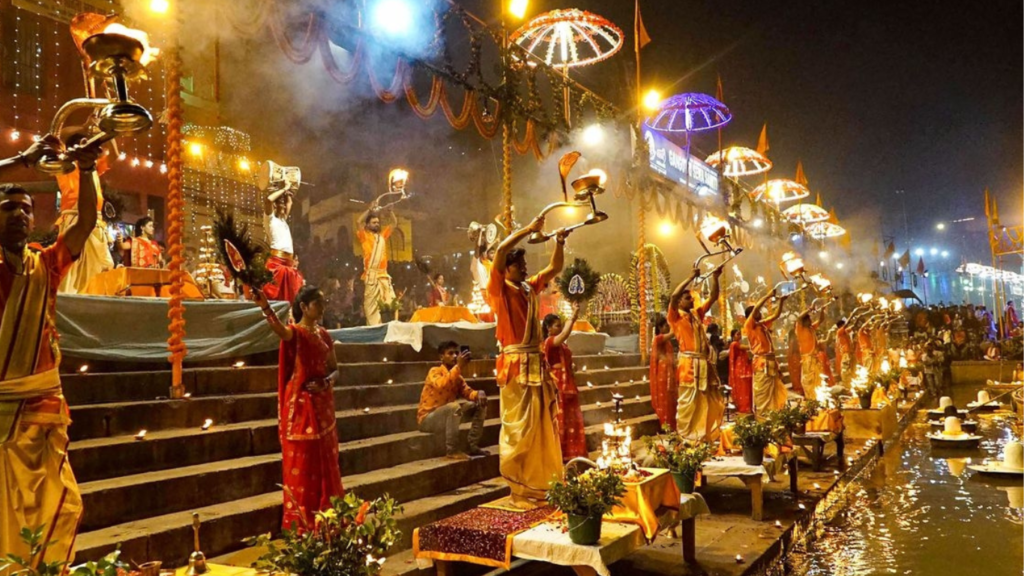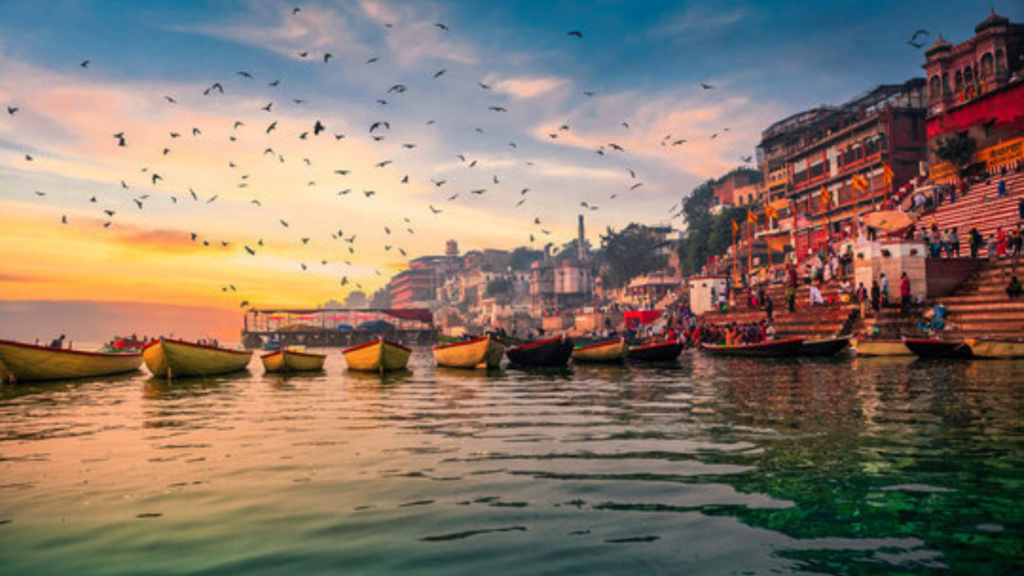
The Holy City of Varanasi

Varanasi, one of the oldest continuously inhabited cities in the world, stands as a spiritual, cultural, and historical epicenter of India. Also known as Kashi and Banaras, Varanasi is a city like no other—an ancient abode of spiritual seekers, sages, and pilgrims. Its significance in Hinduism and other religions has made it an international symbol of devotion, philosophy, and human life’s cyclical nature. Nestled along the banks of the river Ganges, Varanasi has been a site of worship, learning, and profound introspection for millennia.
A Journey Through History
Varanasi’s history dates back to at least 3,000 years, though some accounts suggest its origins may be even older. Archaeological evidence indicates that the city was already a center of religion, culture, and education long before the first Hindu scriptures, the Vedas, were compiled. The name Varanasi is believed to be derived from the two rivers that flow into the Ganges—the Varuna and Assi rivers.
Throughout its long history, Varanasi has been a thriving city for various dynasties, from the Mauryas to the Guptas, and later under Mughal and British rule. However, its significance has always been more spiritual than political. The city was regarded as the abode of Lord Shiva, the supreme deity in Hinduism, and the presiding deity of Varanasi. The belief that death in Varanasi brings liberation from the cycle of rebirth has attracted millions of devotees from all parts of India and beyond.
Spiritual Significance

Varanasi is undoubtedly the holiest of the seven sacred cities (Saptapuri) in Hinduism, and it holds a unique place in the hearts of millions of Hindus. It is believed that Lord Shiva, the god of destruction and regeneration, resides in Varanasi, making it the center of the cosmos. The city’s ancient temples, ghats (riverfront steps), and shrines are focal points of religious activity, offering a connection to the divine that transcends time and space.
The Ganges: The Lifeblood of Varanasi

The Ganges, or Ganga, is more than just a river in Varanasi; it is the very soul of the city. The river holds sacred status in Hinduism, revered as a goddess who has the power to wash away sins and grant salvation (moksha). The ghats along the Ganges are integral to the life and spirituality of Varanasi. These are places where rituals of birth, death, and everything in between are enacted. Pilgrims from all over the world come to perform the ritual of bathing in the Ganges, purifying their minds, bodies, and souls.
One of the most famous ghats in Varanasi is the Dashashwamedh Ghat, which is known for its evening Ganga Aarti. Every evening, thousands of people gather here to witness a grand fire ceremony dedicated to the river goddess, involving chanting, drumming, and the lighting of lamps. The sight of hundreds of floating diyas (oil lamps) on the river is nothing short of mesmerizing, symbolizing the eternal light of divinity.
The Ganges: The Lifeblood of Varanasi

The Kashi Vishwanath Temple is the most sacred shrine in Varanasi and one of the twelve Jyotirlingas, which are considered the holiest temples dedicated to Lord Shiva. Pilgrims visit the temple to offer prayers and seek blessings for spiritual liberation. The temple has been destroyed and rebuilt multiple times throughout history, with the most significant reconstruction undertaken by the Maratha queen Ahilyabai Holkar in the 18th century.
Devotees come to Kashi Vishwanath with the firm belief that a visit to the temple and a dip in the Ganges will cleanse them of their sins and free them from the cycle of rebirth. The temple’s iconic golden dome is a sight to behold, and the atmosphere is filled with the sound of bells and the chanting of mantras.
The Tradition of Cremation
Perhaps one of the most unique aspects of Varanasi is its role as a site for cremation. The Manikarnika Ghat, the main cremation ghat of the city, sees the constant burning of funeral pyres. Hindus believe that dying in Varanasi and having one’s ashes scattered in the Ganges ensures liberation from the cycle of birth and death (moksha). This ritual is deeply symbolic, as it reflects the impermanence of human life and the cyclical nature of existence.
The sight of a cremation ceremony is both poignant and awe-inspiring, as it represents the inevitable end of every living being. Yet, it also symbolizes the beginning of a new spiritual journey, as Varanasi is believed to be the gateway to liberation from material bondage.
Culture and Art in Varanasi

Beyond its religious significance, Varanasi is a cultural treasure trove. The city has been home to poets, philosophers, musicians, and artists for centuries. The spiritual practices of the city, coupled with its deep philosophical roots, have inspired numerous art forms—be it classical music, dance, or literature.
Classical Music and Dance

Varanasi is renowned as the birthplace of the ancient tradition of Indian classical music. The city has produced some of the most celebrated musicians, including the legendary sitar virtuoso Pandit Ravi Shankar and the renowned tabla maestro Ustad Zakir Hussain. The city’s musical heritage can be traced to the temples and spiritual gatherings, where music played a crucial role in connecting with the divine.
The Banaras gharana, a unique style of classical music, has its roots in Varanasi. Both Hindustani classical music and dance forms such as Kathak have flourished in the city, and performances continue to be an integral part of Varanasi’s cultural landscape. Today, the city hosts a variety of music festivals, including the renowned Varanasi Gharana Sangeet Samaroh, where both classical and folk artists showcase their talents.
Varanasi’s intellectual legacy is deeply entwined with the sacred texts of Hinduism, including the Vedas, Upanishads, and the Bhagavad Gita. Scholars and philosophers have long been drawn to the city to engage in study and debate. In addition to being a hub for Hindu philosophy, Varanasi also holds importance for Buddhist and Jain thought, as it is located near Sarnath, the site where Gautama Buddha delivered his first sermon after attaining enlightenment.
The city’s libraries and universities have produced countless scholars over the centuries. One of the most famous institutions in Varanasi is the Banaras Hindu University (BHU), established in 1916. BHU is one of the largest and oldest residential universities in India, and it continues to be a prominent center for learning in the fields of arts, sciences, and social sciences.
Banarasi Sari: A Symbol of Craftsmanship

Another important cultural element of Varanasi is its tradition of weaving. The Banarasi sari, known for its intricate designs and exquisite craftsmanship, is an iconic product of the city. These silk saris are often adorned with gold and silver threads and are worn by brides across India during their wedding ceremonies. The art of weaving Banarasi saris has been passed down through generations, and today, Varanasi remains a major center for silk weaving and textile production.
Varanasi’s Unique Lifestyle and Traditions
Life in Varanasi flows at a different pace—one that is deeply rooted in rituals and traditions. The city is full of life, with narrow alleyways bustling with vendors, pilgrims, and spiritual seekers. Street food, particularly chaats and lassi, is famous, and visitors often find themselves immersed in the energetic atmosphere of the city.
The ritual of sunrise on the banks of the Ganges is something that no traveler to Varanasi can forget. Devotees gather at the ghats early in the morning to perform their ablutions and offer prayers. The soft light of dawn, the sound of temple bells, and the sight of people performing yoga or meditating by the river create a surreal atmosphere of peace and spiritual awakening.
The Contemporary Varanasi

Despite its deep connection to ancient traditions, Varanasi is also a modern city that continues to evolve. The influence of globalization and technology has started to make its mark, with new cafes, hotels, and tech hubs appearing alongside age-old temples and ghats. However, the city’s heart remains firmly rooted in its spiritual and cultural heritage. Varanasi remains a destination for those seeking enlightenment, a deeper understanding of life, and an escape from the pressures of the modern world.
Conclusion
Varanasi is more than just a city—it is an experience. From the quiet reflection by the Ganges to the vibrancy of its festivals and the depth of its spiritual practices, the city offers a glimpse into the heart of Indian civilization. The rituals, the culture, and the history of Varanasi combine to create a place where time seems to stand still, yet everything is constantly changing.
For those who seek spirituality, Varanasi offers a path to liberation; for those who are drawn to history and culture, it is a treasure trove of knowledge and tradition. In a world that is constantly in flux, Varanasi remains a beacon of timeless wisdom, an eternal city where life, death, and rebirth converge in the sacred flow of the Ganges.
Recent Post
Visiting Places in Prayagraj
Allahabad Travel Places
The Holy City of Varanasi
10 Best Places to Visit in Lucknow
Best Places To Visit in Allahabad
